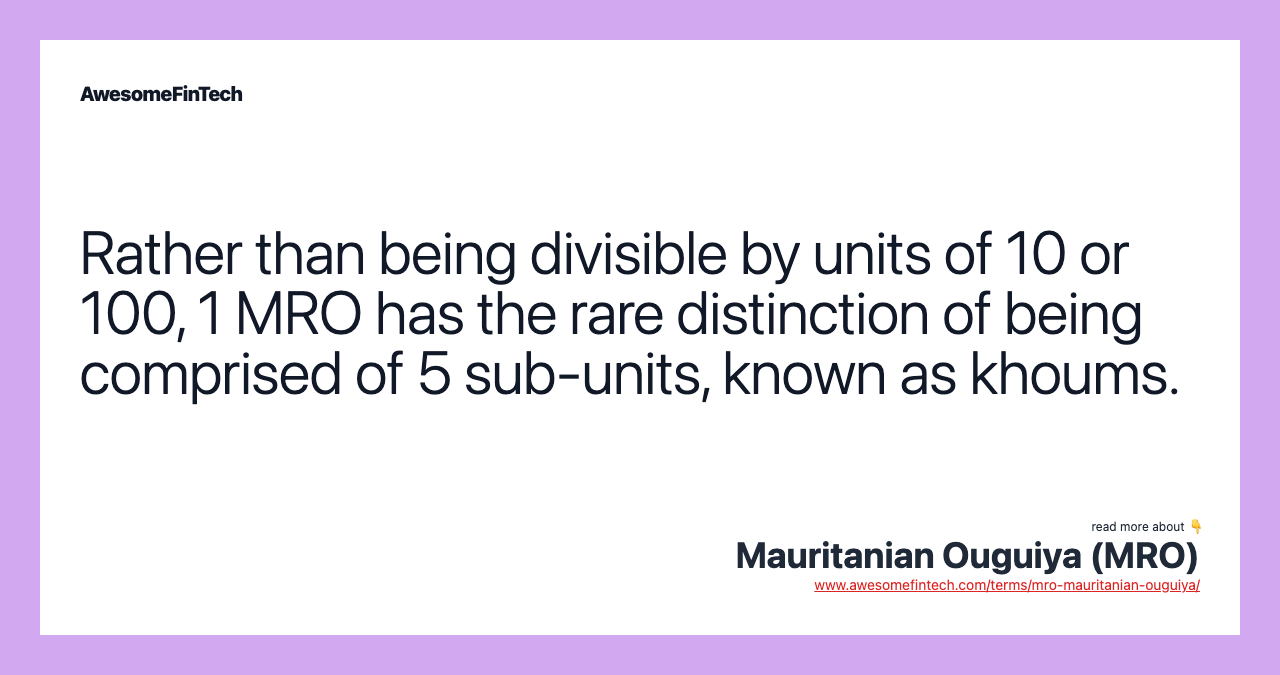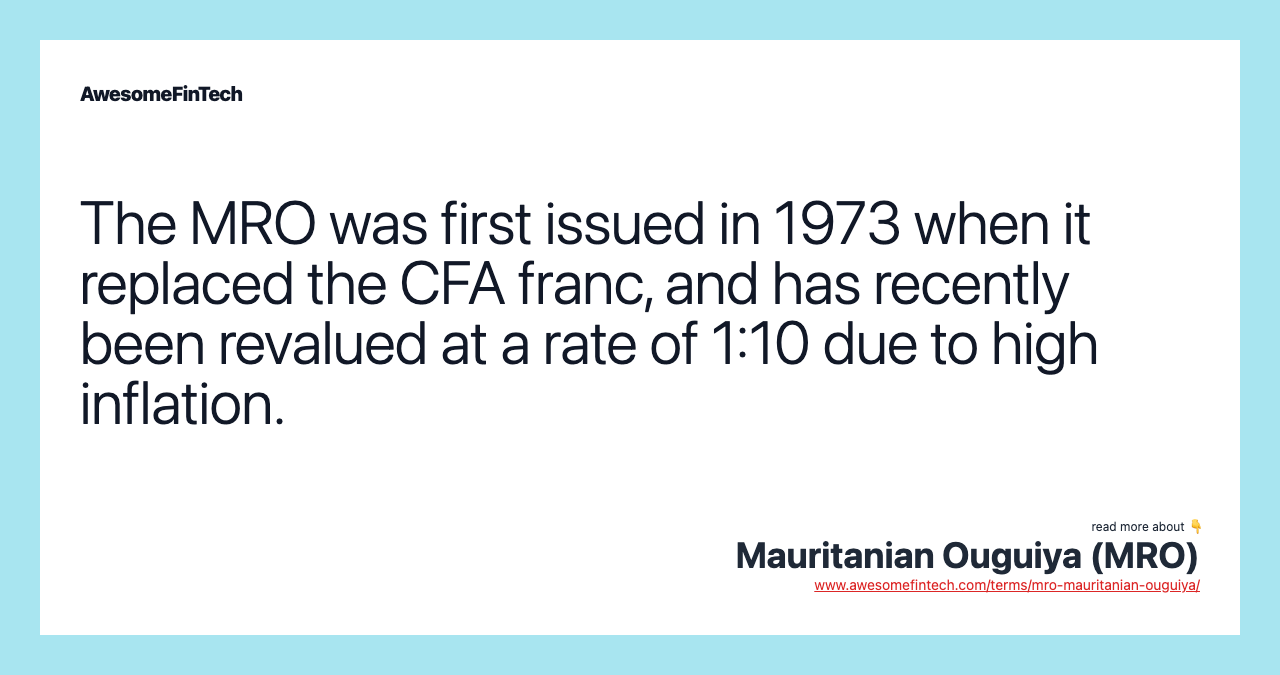Mauritanian Ouguiya (MRO)
MRO is an abbreviation seen in the foreign exchange (forex) market for the Republic of Mauritania _ouguiya_ (sometimes also spelled as the ougiya). According to World Bank data, the Republic of Mauritanian has a growing population, and as a country experienced a 2.3% annual inflation rate and had a gross domestic product (GDP) growth of 6.7% in 2019, which is the most current year of available data. At this time, it replaced the CFA franc, which is a shared currency used in areas of mainland Africa, exchanged at a rate of 5 ouguiyas to 1 CFA franc. Banknotes have denominations of 100, 200, 1,000, 2,000, 5,000 ouguiyas. The Mauritanian ouguiya (MRO) is the official currency of the African Republic of Mauritania. The currency in circulation will gradually transition to the new styles of coins and banknotes throughout 2018. Government officials said the new money is more durable and less prone to counterfeiting, making it safer and more secure.

What Is the Mauritanian Ouguiya (MRO)?
MRO is an abbreviation seen in the foreign exchange (forex) market for the Republic of Mauritania ouguiya (sometimes also spelled as the ougiya). Locally, it is denoted by 'UM'.
One ouguiya divides into five khoums. It has the rare distinction of being one of only two world currencies that are not divisible by units of 10 or 100, the other being the Malagasy ariary, a currency found in Madagascar.
As of September 2020, $1 U.S. is worth roughly 37 MRO. Most commonly, the MRO is exchanged with the euro in the FX market.



Understanding the Mauritanian Ouguiya
The Mauritanian ouguiya first began as the official currency of Mauritania in 1973. At this time, it replaced the CFA franc, which is a shared currency used in areas of mainland Africa, exchanged at a rate of 5 ouguiyas to 1 CFA franc. Banknotes have denominations of 100, 200, 1,000, 2,000, 5,000 ouguiyas. Coins also circulate in values of 1 khoum, and 1, 5, 10, and 20 ouguiyas.
The Central Bank of Mauritania manages and issues the currency. It has recently finished a process of adjusting the denominations of currency in order to adjust for inflation. Redenomination of the currency began in December 2017 at a central bank set rate of 1:10. These new notes are the second ouguiya. The second ouguiya, which is worth ten times its comparable version in the old system, began to go into circulation in January 2018. The currency in circulation will gradually transition to the new styles of coins and banknotes throughout 2018. Government officials said the new money is more durable and less prone to counterfeiting, making it safer and more secure. The updated currency designs also have a more modern and innovative style.
The Economy of Mauritania
The Republic of Mauritania is a country in northwestern Africa that sits along the Atlantic coast. It is made up mostly of a desert landscape with 90% of its landmass lying in the Sahara desert. Many of its residents have a nomadic lifestyle and abide by strict cultural traditions.
Nearly 50% of the nation's gross domestic product comes from fishing, but Mauritania still imports 70% of its food sources. Agriculture and mining also contribute to the nation's income as the majority of its citizens rely on livestock for income and survival. The Mauritania nation experienced several droughts and famine, which coupled with inadequate economic policy, led the country to build up massive foreign debt. Financial assistance through the International Monetary Fund and the World Bank have helped the nation. However, the country still struggles.
Portions of Mauritanian existed under various nomadic tribal rulers for many years until it became part of French West Africa in 1920. During the period of tribal rule, conflicts often flared between groups. Later, when the nation gained its independence in 1960, a new series of conflicts between culturally diverse groups ensued. Slavery remains a problem in the country, as well as an ongoing caste-like system of hierarchy and wide differences in the population's income.
According to World Bank data, the Republic of Mauritanian has a growing population, and as a country experienced a 2.3% annual inflation rate and had a gross domestic product (GDP) growth of 6.7% in 2019, which is the most current year of available data.
Related terms:
CFA Franc
The CFA franc, backed by the French treasury, refers to both the Central African CFA franc and the West African CFA franc and is used by 14 countries. read more
Egyptian Pound (EGP)
The EGP or Egyptian Pound is the official currency of Egypt. Learn about the history of the EGP and how to convert the U.S. dollar to the EGP. read more
Foreign Exchange (Forex)
The foreign exchange (Forex) is the conversion of one currency into another currency. read more
HNL (Honduran Lempira)
HNL is the foreign exchange currency abbreviation for the Honduran Lempira, the currency for the Republic of Honduras. read more
Kenyan Shilling (KES)
KES is the foreign exchange (FX) trading symbol for the Republic of Kenya shilling used in Kenya, the Sudan, and Somalia. read more
Polish Zloty (PLN)
The Polish zloty (PLN) is the national currency of Poland, issued by Narodowy Bank Polski. read more
Redenomination
Redenomination is the process of changing the value of a currency, typically due to hyperinflation or when a new currency is adopted. read more
Serbian Dinar (RSD)
The RSD (Serbian dinar) is the ISO currency code for the official currency of the Republic of Serbia and is subdivided into 100 paras. read more
Sudanese Dinar (SDD)
The Sudanese dinar (SDD) was the currency for Sudan between June 1992 and January 2007. read more